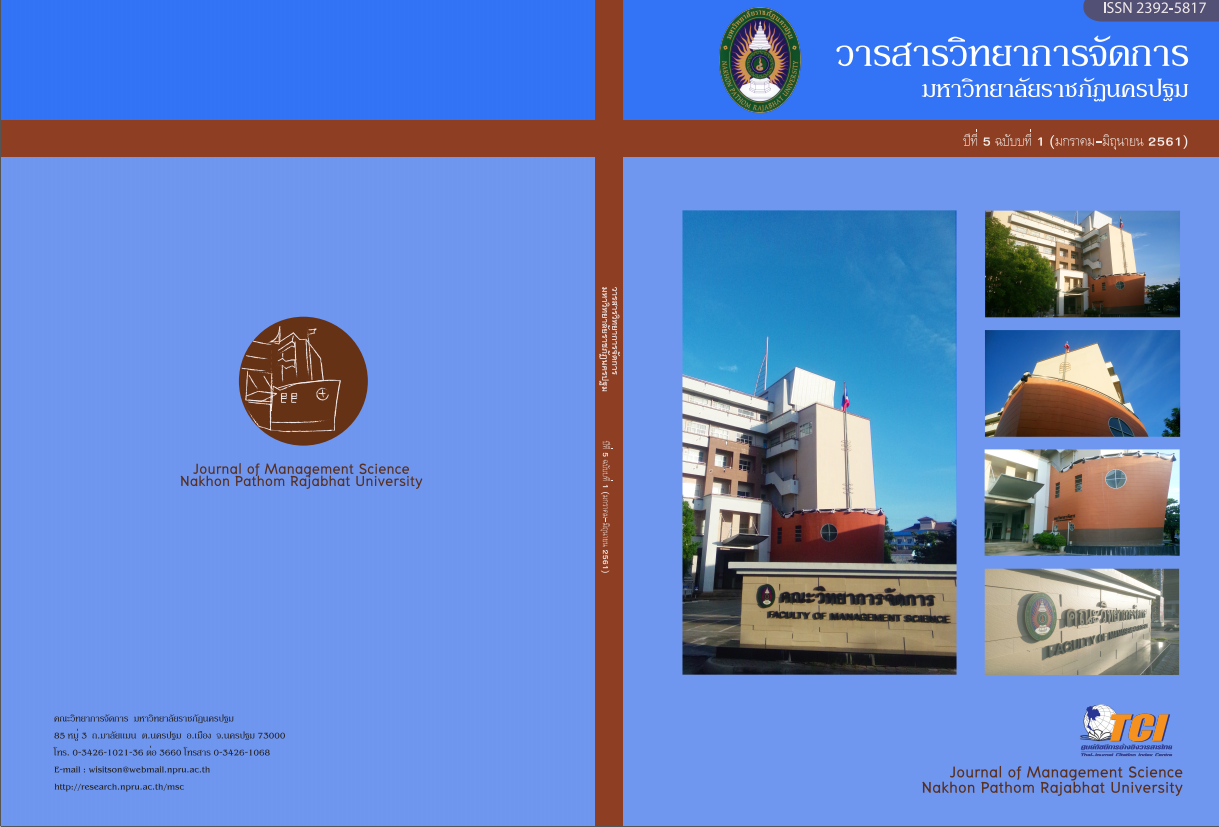Evaluation of Organizational performance using the Balanced Scorecard Case study of Thanalaeng Railway Station, Lao
Main Article Content
Abstract
This study aims to evaluate the efficiency of organization management and study figure out how to improve service quality of Thanaleng train station by using the Balanced Scorecard (BSC). The evaluation criteria include financial customer internal processes and learning and development. The questionnaires were applied to collect data from Thanaleng train station’s passenger and staffs. The passenger including Lao people and formers amount 395 samples and 26the development of quality services. The depth executive interviews Thanaleng Railway Station staffs replied the questionnaires. The results of Thanaleng train station’s performance point out that:
1. Financial perspective was at a good level. Thanaleng train station receive government funding to manage their expenses within the organization. The revenue from ticket sales at 25 percent are given to the government.
2. service quality. The problem of service are accessibility to train station no facilities ineffective communication and staff lacking service skill.
3. Internal process perspective was at the fair level. The problem of internal process are lacking of organizational development staffs’s knowledge staffs’s experience.
4. Learning and Development perspective need to improve urgently. The problem of Learning and Development perspective are employee’s lacking of morale of work and opportunity to improve their knowledge
The approaches to improve service quality of the thanaleng railway station are following:
1. Financial perspective: Due to the annual expenses of the thanaleng railway station are provided by Lao Railway Authority then any income-expenses should be recorded carefully to avoid the occurrence of corruption.
2. Customer perspective: Transportation system to connect to railway station should be improved. Moreover the facilities within train station should be provided for passengers such internet restaurants ATM duty free shops and cleaned bathrooms.
3. Internal process perspective: the organization should have a beforehand operating plan and use modern technology to reduce resources usage of the organization.
4. Learning and development organization: the organization should support employee in every aspects by providing training courses in order to increasing their knowledge.
Article history : Received 5 March 2018
Revised 10 May 2018
Accepted 14 May 2018
SIMILARITY INDEX = 0.00
Article Details
The views and opinions of the article appearing in this journal are those of the author. It is not considered a view and responsibility of the editorial staff.
References
กองคุ้มครองทางรถไฟ กระทรวงโยธาทิการ และขนส่ง (2560 ก). สรุปสถิติผู้โดยสารที่มาใช้บริการรถไฟ (หนองคาย - ท่านาแล้ง - หนองคาย). บทสรุปการจัดตั้งปฏิบัติงานประจำปี พ.ศ.2560 ของกองคุ้มครองทางรถไฟ. 2.
กองคุ้มครองทางรถไฟ กระทรวงโยธาทิการ และขนส่ง (2560 ข). สรุปรายรับส่วนแบ่ง 25% จากการจำหน่ายตั๋ว เวียงจันทน์ - หนองคาย – เวียงจันทน์. บทสรุปการจัดตั้งปฏิบัติงานประจำปี พ.ศ.2560 ของกองคุ้มครองทางรถไฟ. 3.
ณฤดี ถาวรบุตร. (2547). ผลการนำ Balanced Scorecard. ไปใช้กับโรงพยาบาลในสหรัฐอเมริกา.วารสารบริหารธุรกิจ. (27)101 : 63-75.
นภดล ร่มโพธิ์. (2546). เครื่องมือการประเมินผลการปฏิบัติงานองค์กร. กรุงเทพฯ : อิเมจิเนียริ่ง.
พสุ เดชะรินทร์. (2547). เส้นทางจากกลยุทธ์สู่การปฏิบัติด้วย Balanced Scorecard และ Key Performance Indicators. (พิมพ์ครั้งที่ 12). กรุงเทพฯ : โรงพิมพ์แห่งจุฬาลงกรณ์มหาวิทยาลัย.
ศุภลักษณ์ สุริยะ. (2556). แนวทางการพัฒนาคุณภาพการบริการของแผนกต้อนรับส่วนหน้าโรงแรม เพื่อรองรับนักท่องเที่ยวอาเชียน กรณีศึกษา : โรงแรมบูติก กรุงเทพมหานคร. วิทยานิพนธ์ปริญญามหาบัณฑิต. วิทยาลัยสถาบันบัณฑิตพัฒนบริหารศาสตร์.
ศรัยกร บุษยะมา. (2545) การวัดประสิทธิผลขององค์กร ด้วยวิธีการแบบดุลยภาพ กรณีศึกษา บริษัท ธีรพัฒน์อินดัสตรี้ส์ คอร์ปอเรชั่น จำกัด. วิทยานิพนธ์ปริญญาครุศาสตร์มหาบัณฑิต.สาขาการจัดการคุณภาพ. มหาวิทยาลัยราชภัฏสวนสุนันทา.
Kaplan, R.S. and Norton, D.P. (1996) .Using the Balanced Scorecard as a Strategy Management System. Harvard Business Review. Jan-Feb. : 75-85.
Parasuraman, A. Berry, L.L.; & Zeithaml V.A. (1985). A Conceptual Model of Service Quality and Its Implications for Future Research. Journal of Marketing: 49, 41-50.
Parasuraman, A. Zeithaml, V. A. & Berry L.L. (1988). SERVQUAL: A multiple-item scale for measuring consumer perceptions of service quality. Journal of Marketing .64 : 12-40.
Parasuraman, A. Zeithaml, V. A. & Berry L.L. (1994). Alternative Scales for Measuring Service Quality A Comparative Assessment Based on Psychometric and Diagnostic Criteria Journal of Retailing : 201-230.
Parasuraman, A. & Berry, L.L. (1990). An empirical examination of relationships in an extended service quality model. Cambridge Mass : Marketing Science Institute.
Zeithaml Valarie A. (1988). Consumer Perceptions of Price Quality and Means-End Model and Synthesis of Evidence. Journal of Marketing. 52 (July) : 2-22.


